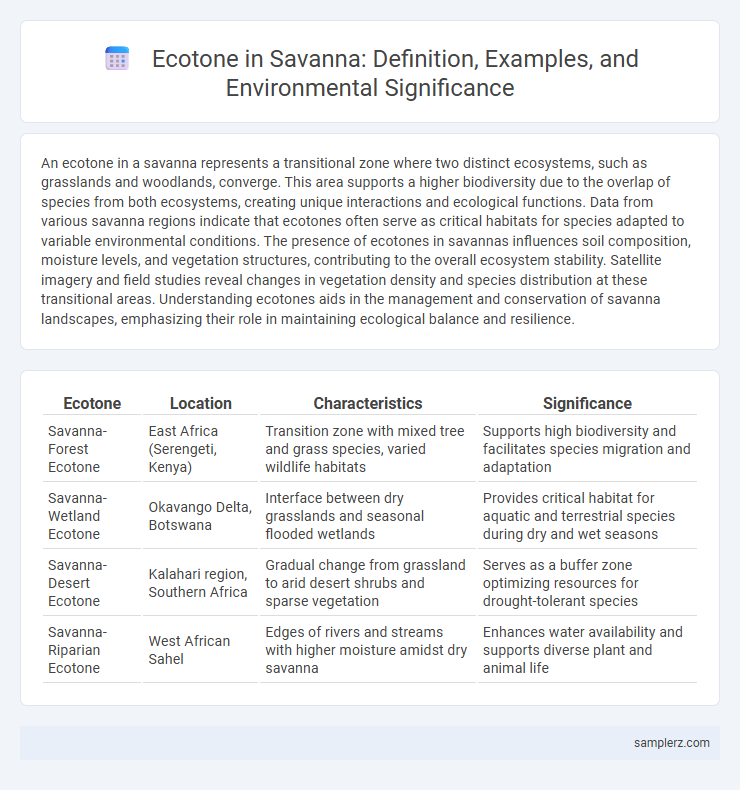An ecotone in a savanna represents a transitional zone where two distinct ecosystems, such as grasslands and woodlands, converge. This area supports a higher biodiversity due to the overlap of species from both ecosystems, creating unique interactions and ecological functions. Data from various savanna regions indicate that ecotones often serve as critical habitats for species adapted to variable environmental conditions. The presence of ecotones in savannas influences soil composition, moisture levels, and vegetation structures, contributing to the overall ecosystem stability. Satellite imagery and field studies reveal changes in vegetation density and species distribution at these transitional areas. Understanding ecotones aids in the management and conservation of savanna landscapes, emphasizing their role in maintaining ecological balance and resilience.
Table of Comparison
| Ecotone | Location | Characteristics | Significance |
|---|---|---|---|
| Savanna-Forest Ecotone | East Africa (Serengeti, Kenya) | Transition zone with mixed tree and grass species, varied wildlife habitats | Supports high biodiversity and facilitates species migration and adaptation |
| Savanna-Wetland Ecotone | Okavango Delta, Botswana | Interface between dry grasslands and seasonal flooded wetlands | Provides critical habitat for aquatic and terrestrial species during dry and wet seasons |
| Savanna-Desert Ecotone | Kalahari region, Southern Africa | Gradual change from grassland to arid desert shrubs and sparse vegetation | Serves as a buffer zone optimizing resources for drought-tolerant species |
| Savanna-Riparian Ecotone | West African Sahel | Edges of rivers and streams with higher moisture amidst dry savanna | Enhances water availability and supports diverse plant and animal life |
Introduction to Ecotones in the Savanna
Ecotones in the savanna represent transitional zones where grasslands meet woodlands, creating unique habitats that support high biodiversity. These areas often host species from both ecosystems, such as acacia trees mingling with tall grasses, fostering increased ecological interactions and resilience. Understanding savanna ecotones is crucial for conservation efforts aimed at preserving the dynamic balance between vegetation types and wildlife.
Defining Ecotones: Transition Zones in Nature
An ecotone in savanna ecosystems is the transitional zone where grasslands meet woodlands, creating a rich biodiversity hotspot. This area supports species from both adjacent habitats, such as acacia trees and tall grasses, fostering unique ecological interactions. Ecotones in savannas play a crucial role in nutrient cycling and serve as buffers against environmental changes.
Key Features of Savanna Ecotones
Savanna ecotones, where grasslands transition to woodlands, exhibit a blending of biodiversity with both savanna grasses and scattered tree species such as Acacia and Baobab. These areas display distinct variations in soil moisture and nutrient availability, supporting diverse fauna adapted to both open and shaded habitats. Fire regimes and rainfall patterns are crucial dynamic factors influencing species composition and ecological processes within savanna ecotones.
Grassland–Forest Boundary: The Classic Savanna Ecotone
The Grassland-Forest boundary in savannas represents a classic ecotone where grassy plains transition into wooded areas, creating a unique habitat rich in biodiversity and species adapted to both ecosystems. This ecotone supports a mix of fire-adapted grasses and fire-sensitive tree species like acacias and baobabs, influencing nutrient cycling and carbon storage. The dynamic interplay between fire frequency, herbivory, and climatic factors shapes the spatial distribution of flora and fauna, making the savanna ecotone critical for ecological research and conservation efforts.
Riverine Ecotones: Where Savannah Meets Watercourses
Riverine ecotones in savannas are dynamic transitional zones where grasslands intersect with freshwater ecosystems, creating unique habitats with high biodiversity. These areas support diverse species like crocodiles, hippos, and numerous bird species that rely on both terrestrial and aquatic resources. The constant interaction between savanna vegetation and riverine water flow enhances nutrient cycling and promotes ecological resilience in these regions.
Shrubland–Savanna Transition Zones
Shrubland-Savanna Transition Zones represent a prime example of ecotones within savanna ecosystems, where dense shrub vegetation gradually blends into open grassy savanna. These areas support high biodiversity by providing habitats for species from both shrubland and savanna biomes, including mammals like impalas and smaller birds specialized in shrub cover. The unique microclimatic conditions and soil gradients in these ecotones influence fire regimes and nutrient cycling, essential for maintaining ecological balance in savanna landscapes.
Mountain Slope Ecotones within Savanna Landscapes
Mountain slope ecotones within savanna landscapes represent transitional zones where grassy plains meet montane forest patches, creating unique biodiversity hotspots. These ecotones support diverse flora and fauna adapted to varying microclimates, such as drought-resistant savanna grasses blending with moisture-loving mountain species. The gradient of elevation and temperature in these zones plays a critical role in species distribution and ecosystem resilience against climate variability.
Biodiversity Hotspots: Species in Savanna Ecotones
Savanna ecotones, transitional zones between grasslands and forests, serve as vital biodiversity hotspots supporting unique species assemblages adapted to fluctuating environmental conditions. These areas host a rich diversity of flora such as Acacia and Baobab species, alongside fauna including elephants, lions, and diverse bird populations like hornbills and rollers. The dynamic interplay of resources and microhabitats in savanna ecotones fosters ecological resilience and evolutionary processes critical for ecosystem stability.
Human Impact on Savanna Ecotones
Savanna ecotones, transitional zones between grasslands and forests, are highly sensitive to human activities such as agriculture, urbanization, and deforestation, which significantly alter their biodiversity and ecosystem services. Increased land conversion in these ecotones disrupts natural fire regimes and soil composition, leading to habitat fragmentation and loss of native species. Monitoring and managing human impact on savanna ecotones is crucial for preserving their ecological balance and supporting sustainable land use practices.
Conservation Strategies for Ecotone Areas in Savanna
Ecotone areas in savannas, such as the transition zones between grasslands and woodlands, are biodiversity hotspots requiring targeted conservation strategies that include controlled burning, invasive species management, and habitat restoration. Preserving these zones enhances species migration corridors and maintains ecological balance by supporting both savanna and forest species. Integrating community-based conservation practices with scientific monitoring improves the resilience of savanna ecotones against climate change and human disturbances.

example of ecotone in savanna Infographic
 samplerz.com
samplerz.com